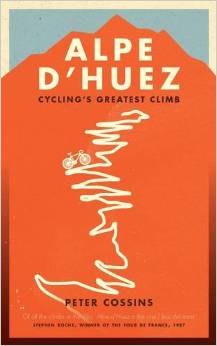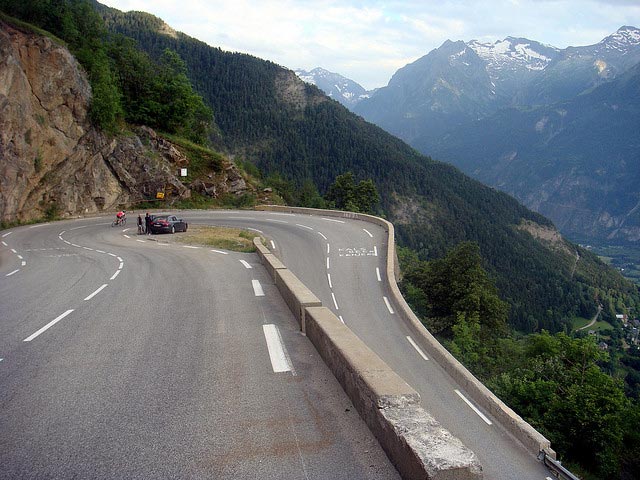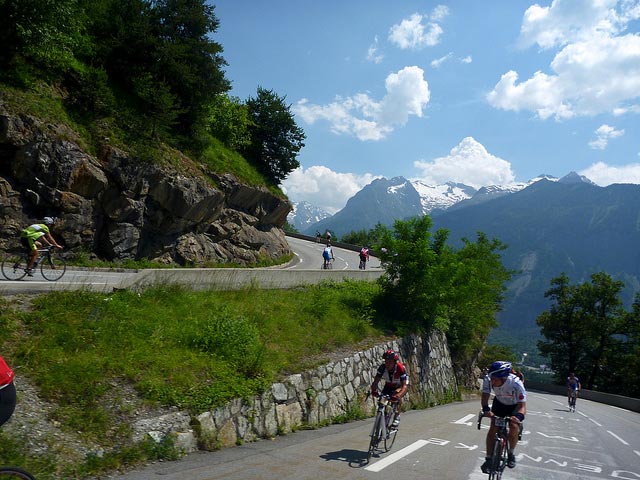 Alpe d’Huez by Peter Cossins is a cycling history of the famous Alpine climb. The book looks at the dramatic moments on Alpe D’Huez which have featured in the Tour de France. It also looks at some of the winners and the factors that make Alpe d’Huez such an iconic climb. It also examines the combination of myth and reality behind the great climb and examines some of the criticisms of the climb and whether it has become a victim of its own success.
Alpe d’Huez by Peter Cossins is a cycling history of the famous Alpine climb. The book looks at the dramatic moments on Alpe D’Huez which have featured in the Tour de France. It also looks at some of the winners and the factors that make Alpe d’Huez such an iconic climb. It also examines the combination of myth and reality behind the great climb and examines some of the criticisms of the climb and whether it has become a victim of its own success.
I received a copy of Alpe d’Huez by Peter Cossins on my way to the Pyrenees a few weeks ago. It was good timing because riding up the Pyrenees gave a much more vivid understanding of the attraction behind real mountains. As Cossins mentions towards the end of the book – a succession of doping scandals in cycling has caused a shift from a focus away from riders to the actual climbs. Modern day magazines place less emphasis on just the cycling personalities – the climbs themselves have become much more central to the interest in cycling. Witness the explosion in books about climbs and mountains. Riders come and go, but mountains are always there. Mountains are 100% reliable – they don’t have skeletons in the cupboard, but are a permanent feature on the landscape – tantalising any cyclist in the world to ‘come and have a go.’ As it is often said, it’s hard to have a knock around on Center Court, but anyone with a bike can ride up Alpe d’Huez and compare their times.
Insights from the riders
A strength of the book is that it gives very different insights from riders who have ridden and or won up to Alpe D’Huez. Perhaps the strongest account comes from Andy Hampsten who won on Alpe D’Huez in 1992. Hampsten talks about both the beauty of his win, but also the travails of fighting his way passed drunken spectators tumbling onto the course. It is a great account of suffering and winning on Alpe D’Huez. In a book, where doping is never far from the surface, Hampsten is a rider who always had a reputation for riding clean (Hampsten at Daily Peleton on EPO use) – He won in 1992, just before EPO’s trickle into the peleton became a floodgate. What I liked about reading Hampsten account is that there felt a very genuine sporting achievement.
Myth and reality

One thing I didn’t expect about reading the book was to be more conscious of the downside of the famous climb on race day. From a distance Alpe d’Huez seems the magic climb to tackle. But, actually the hordes of spectators (many who are quite drunk by the time the race arrives) can create an almost feral attitude.David Millar described the climb as:
“a bit like riding through a big village fair where everyone is drunk.”
It is a heady mix of energy, intensity, excitement, creating a whole mixture of emotions amongst those who ride.
The book is neither hagiographic or trying to be critical. It just makes you aware that there are many facets behind the climb, the legend and the reality. The beauty and the suffering; a veritable pot-pourri of human experience.
Interesting sub-plots

A challenge with cycling books is to offer something new, something that hasn’t been covered before. For me I learnt a lot about the life and careers of people like Van Impe, Zoetemelk and also very unknown winners like Joaquim Agostinho and Beat Breau. Joaquim Agostinho became a national hero in Portugal – largely on the back of his exploits in the Tour de France and Alpe d’Huez in particular.
This is one recurring feature that for many who excelled on Alpe D’Huez – it was the career defining moment of their career. From the Zoetemelk / Van Impe’s battle in 1976 to Carlos Sastre taking the yellow jersey in 2008 and Christopher Riblon in 2013
Does it make me want to go and climb Alpe d’Huez?
Yes, but then I think I wanted to go and climb Alpe d’Huez the moment I saw the foothills of the Pyrenees. It is good to be aware that it is not the most beautiful climb; it is good to know there are many more beautiful and epic climbs in the nearby areas – but nothing can change the fact that Alpe d’Huez is the climb a cyclist wants to ride. It is the climb that transcends cycling – even non-cyclists can relate to Alpe D’Huez.
Does it make me want to go and spectate at the Alpe d’Huez?
If I went to the Tour de France to watch, I wouldn’t choose Alpe d’Huez.
Is it a good read?
Yes, it is a good read. I got through it in a couple of weeks and thought it quite an interesting and revealing account of the great climb.You get the feeling that it is the climb that is the real star of the show. There are too many astericks by the lists of winners, the spectators may not always behave with decorum, but the mountain remains like a blank canvas for whatever will happen in the future.
Alpe d’Huez
- Distance: 8.8 miles
- average gradient: 8%
- Height gain: 3,598ft / 1,096m
The Tour de France climb often finishes a km earlier.
Related
- Alpe d’Huez by Peter Cossins at Amazon.co.uk

1 thought on “Alpe d’Huez – Peter Cossins review”